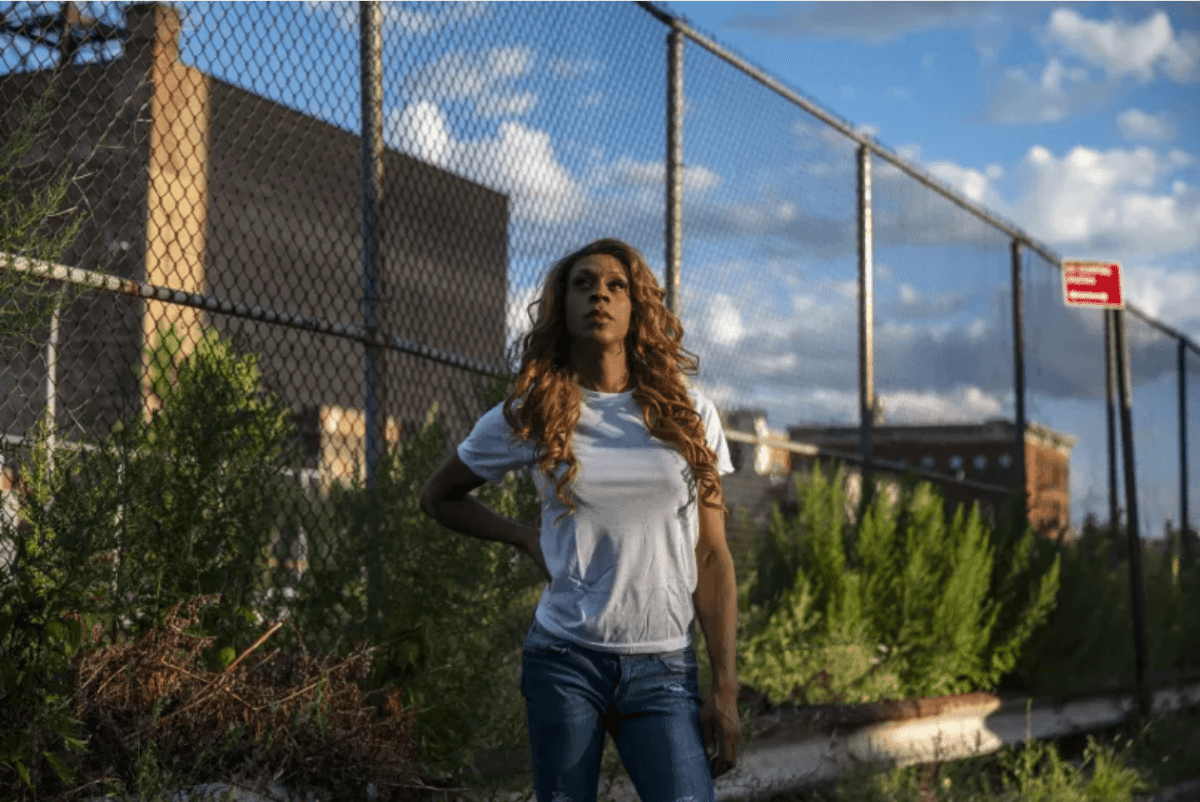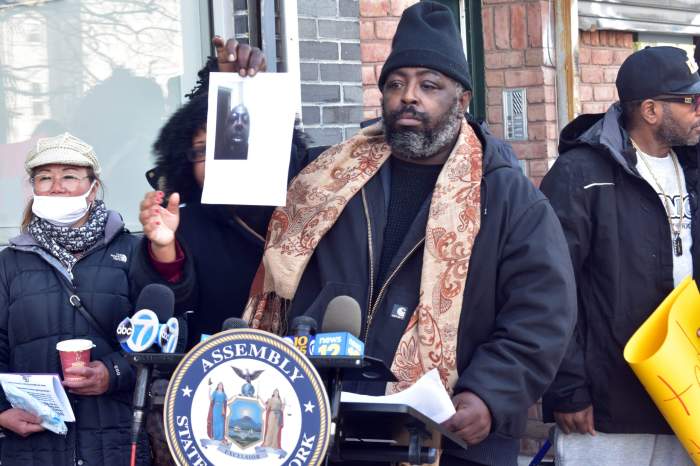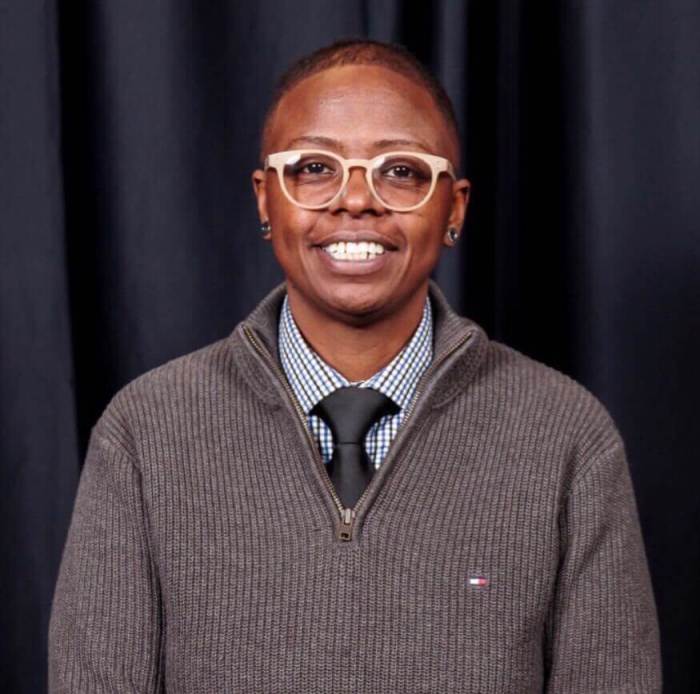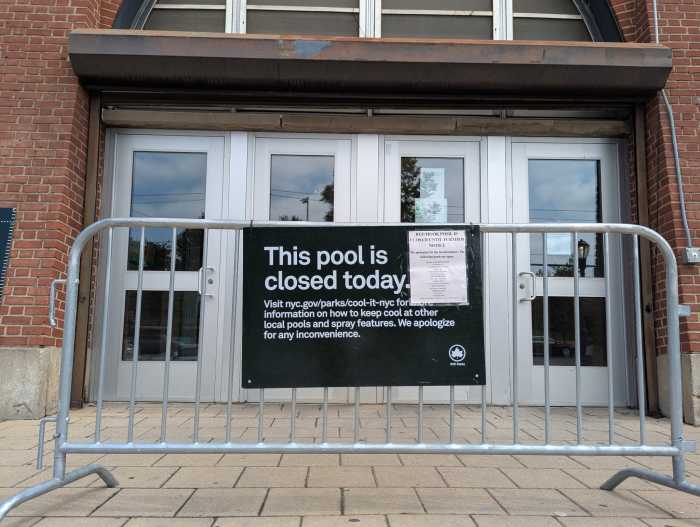This article was originally published on August 15 by THE CITY.
This reporting was produced in partnership with New York Public Radio station WNYC and its news site Gothamist.
In 1979, the city Department of Correction created a special unit within the men’s jails on Rikers Island to house gay men and transgender women.
The separate housing area — the first of its kind in the country — was initially a major success and touted as a revolutionary way to protect that vulnerable population.
But 43 years later, a new report from a task force convened by the Board of Correction finds that the city jails system continually fails to identify, protect, and properly care for transgender, gender non-conforming, non-binary, and/or intersex (TGNCNBI) people in custody.
Among some of the report’s findings: transgender women are routinely sent through a men’s jail intake facility, sometimes for days. Guards threaten to switch trans detainees to opposite-sex housing for not following mundane rules. Many struggle for months to get basic medication.
And the task force found that in a majority of cases studied, people were housed in units inconsistent with their gender identity.
The report comes as Correction Commissioner Louis A. Molina has embarked on his reform plan to avoid a potential federal takeover of the jails system. THE CITY and WNYC shared the full task force report with the Department of Correction last week.
A spokesperson for the department, Patrick Rocchio, said that the efforts of the task force and others were welcome as part of a larger effort to support and protect people across the gender spectrum. Department staff were involved as members of the task force and in giving feedback for the report.
“Since 2018, we have been a national leader in housing TGNCNBI people in custody in a manner consistent with their health and safety, and their gender identities,” Rocchio said in a statement.
He added, however, that “not all of the opinions, conclusions, or recommendations in the report reflect the views of the agency or correctional best practices,” and that the task force did not provide the final report to the department.
Some criminal justice reformers and jail experts have called for the federal judge overseeing a class action lawsuit against the Department of Correction to appoint a receiver who would be given total autonomy to run the agency.
In making their case for that drastic move, they cite the 11 deaths behind bars this year, hundreds of missed medical appointments that have led to court-issued fines, and a continued rise in violence.
Seeking Safety
The report into the treatment of TGNCNBI people was compiled by a task force created after the City Council passed Local Law 145 approximately one month after the June 2019 death of Layleen Polanco. The 27-year-old transgender woman passed away from an epileptic seizure inside a solitary cell she was placed inside despite a history of seizures.
/cdn.vox-cdn.com/uploads/chorus_asset/file/20002459/844fe45f423d39f1aee25cef72b6b1e6f140_layleen_polanco_fb.w700.a700x467.2x.jpg)
The task force was also created after TGNCNBI people repeatedly testified at Board of Correction oversight hearings and spoke out during rallies about alleged abuses they experienced behind bars.
It is currently comprised of 19 people, including some advocates who have a long history of assisting transgender people behind bars, delegates from the City Council, and Correctional Health Services staffers.
The report, which reviewed practices dating back to 2018, provides previously unavailable data revealing the city’s criminal justice system’s frequent failure to properly classify and house detainees by their gender identities.
As of March 11, 2022, for example, of the 41 incarcerated trans people whose gender identity the task force could confirm, 63% were in gender-misaligned housing.
The lack of proper identification sometimes started when people were arrested and the police failed to use people’s preferred name and gender marker, according to the task force report. Instead, cops use official documents, like a driver’s license, which aren’t always updated.
Or, if a person is arrested without ID, they rely upon old criminal records or their own sense of the person’s gender identity.
The prosecutors handling the cases then typically relied on how the NYPD labels the person while drafting the criminal complaint, according to the report. Court officers and judges also frequently used that inaccurate paperwork.
In jail, transgender people are far likelier than others to be sexually assaulted or beaten up, according to multiple national studies. That is partially because jail officials fail to properly house them according to their gender identity, according to the research and advocates.
In some cases, though, they are merely tossed into solitary confinement or some sort of restrictive housing, studies show.
DOC maintains that people have the opportunity to disclose their identity at intake or at any point during their incarceration.
In Rikers and other city jails, transgender women are often still placed in male housing areas based on their physical anatomy, according to the 146-page report. The task force interviewed approximately 35 transgender, non-binary and or intersex detainees.
Additionally, jail officials often withhold, or threaten to take away, hormone therapy treatment for transgender women, according to former detainees.
“There is no system right now currently to ensure that trans people can go through the system safely, and end up in the intake facility that’s aligned with their gender identity,” said Deborah Lolai, supervising attorney of the LGBTQ Defense Project at The Bronx Defenders and one of the report’s authors.
Just Put ‘F’
Frequently, the task force found, misclassifications stemmed from outdated court procedures. Court officers and other staff frequently rely on erroneous police reports or district attorneys’ criminal complaints, rather than interviews with defendants, to classify gender identities, resulting in improper housing assignments by the Department of Correction.
Take the case of London Reynolds, a transgender woman who was forced to spend several months in male housing units on Rikers Island after her 2020 arrest because her gender was marked as “male” on a slip filled out by court staff.
Soon after arriving on the island, Reynolds alleges, a male detainee broke into her cell and sexually assaulted her — an incident that she says guards failed to act on because they were unwilling to deal with the paperwork.
In another incident, Reynolds says, two other incarcerated men told her she should die and called her a “stupid gay motherfucker” as one hit her with a cane, a beatdown that resulted in her being taken out on a stretcher.
Even in her sleep, she says, she was not safe. Once while in her cell, Reynolds says, she awoke to find a man on top of her. While raping her, the man, she says, threatened to stab her with a metal object.
After her second alleged sexual assault on the island, Reynolds says she reported the violence to a jail captain, prompting the department to move her to a different men’s general population unit.
“None of this would have happened if they just put ‘F’ on my paperwork,” Reynolds told the task force.
The trans unit has been moved around repeatedly. Like much of the city’s beleaguered correction department, it has long failed to meaningfully work as initially intended.
In its first decade the unit became “very unstructured” and officers assigned there failed to stop sexual violence, said Mik Kinkead, a staff attorney at the Legal Aid Society, who spoke to multiple people who were housed there at the time.
The unit was shut down at some point in the 1990s and was only reopened in 2014 after years of advocacy. It houses transgender women and female-identifying TGNCNBI people but no cisgender gay or bisexual men.
A Long-Troubled Unit
The report is not the first inquiry to find serious problems in how the Department of Correction houses TGNCNBI people.
In 2018, the city’s Board of Correction released a report that concluded the department lacked a system to properly house transgender people.
The department in 2014 issued a new Transgender Housing Unit (THU) policy, requiring transgender men to be housed in protective custody at the Rose M. Singer Center (RMSC) on Rikers, which normally houses female inmates, and transgender women to be housed in a separate area inside a facility designed for men.
The special housing unit for women was soon moved to a different area, jail officials said.
/cdn.vox-cdn.com/uploads/chorus_asset/file/23644196/Rikers_Island.jpg)
In April 2015, the department opened a THU for transgender women in the North Infirmary Command facility on Rikers.
Correction officials three months later relocated the THU to the Manhattan Detention Center (MDC) in Chinatown. But officers assigned there were never given added sensitivity training, according to Kinkead, who was asked by jail officials to develop the course.
“It was so neglected and ignored,” Kinkead said. “Officers consistently misgendered people.”
Around August 2018, the unit was moved to the Rose M. Singer Center where women are housed on Rikers. That’s where the “Special Considerations” unit is currently located.
There are only two people in the unit, according to the Board of Correction, which is notified every time a TGNCNBI person who has shared their identity with the DOC is moved.
The Legal Aid Society represents at least 10 transgender women or feminine non-binary people who are now being housed as men, Kinkead said. Six of those 10 have applied to be moved to the women’s facility, he added.
Jail officials contend that it is difficult to make sure potentially violent detainees, or known gang leaders, aren’t faking to get moved from the general population into the special unit.
“We cannot tell anyone how they feel,” said a formerly incarcerated transgender woman who spoke to THE CITY and WNYC, who asked to be named as Ms. F. “If we turned away every single inmate that we perceive as a gang member as a man, or because of how they looked, or whatever the case may be, we would be turning away so many people.”
Some people in the unit are just beginning their transition, she added.
“You don’t need hormones to identify as transgender,” she said. “I’ve never seen a gang member come there. That’s bullshit.”
Not Gender Affirming
One high-ranking Correction Department official contended that people in the transgender unit are likelier to have fights among themselves than tends to happen in other units.
Kinkead said that perception reflects “misogyny and a lot of misunderstanding.”
Transgender detainees are also under additional pressure and worry about being put in a general population unit.
“When there was only one housing unit to go to, there was a lot of worry that anyone misbehaving, anyone being different in any kind of way, would get the whole unit nullified,” he said. “And so there was a lot of one-upmanship around like, are we being female enough?”
In one case highlighted in the report, Ms. F was denied gender-affirming surgery in February 2019. She pushed for over a year for the procedure and her criminal sentencing on credit card theft was postponed so she could receive the necessary surgical care.
At one point, Ms. F. says she was told by a surgeon at Elmhurst Hospital that the public facility doesn’t provide that surgery.
“Unfortunately, the surgery remained unavailable as of the last week of March 2020, when she was released from DOC custody,” the report said.
In jail, Ms. F. said she was initially put in a male intake pen for several days.
“It was traumatizing,” she told THE CITY and WNYC during an interview last week. “The men didn’t talk to me, and if they did, they were grabbing their penises and trying to get something sexual.”
When she was moved to a transgender unit after a week, officers there constantly threatened to move her back to the male unit.
“The threats were obviously affecting my mental health and who I was as an individual,” she said. “During that time I became an advocate for myself because I knew what they were doing was wrong.”
Policy Demands
The task force report offers numerous recommendations for policy changes that could increase safety for TGNCNBI detainees.
Before arraignments in New York City, health officials screen defendants for medical or mental health concerns. During this debriefing session, they could also confirm their correct gender identities and notify the court of any incorrect gender classifications in law enforcement paperwork, so that staff could correct the slips that the Department of Correction uses for housing assignments.
Such procedural fixes could go a long way, but Lolai notes that sometimes even in cases where a judge affirms what a defense attorney says about a defendant’s gender identity, those slips, known as “securing orders,” can still go to the Department of Correction with the opposite gender classification.
“There have been times where judges have asked court officers to do it, and the court officer completely ignored the judge’s order,” said Lolai.
“Court officers have made really nasty remarks, rooted in transphobia, like, ‘Well, she’s not a woman, so I’m not going to mark her as a woman.’”
The Office of Court Administration did not respond to a reporter’s inquiry about officers’ training, or whether such actions by court staff were subject to any kind of discipline.
For the jail system too, the task force members said there’s a “need for a culture change.” Officers who lack sensitivity or break the rules should be subject to “strict disciplinary measures.”
Naomi Waters, another transgender woman who spent time in a male facility on Rikers Island earlier this year, told THE CITY some guards there openly questioned her gender identity.
On one occasion, Waters said she asked for a sports bra to wear but was brushed off by a female correction officer.
“She looked at me up and down, [and said] ‘Are those things even real?’” Waters recalled. When the incarcerated woman asked her what she meant, she said the guard repeated the question and walked away laughing.
Afterwards, Waters demanded to speak to the officer’s supervisor, who she says also brushed her off.
“At the end of the day, I’m still human,” she said. “It’s a God-given right, that I have these things under your care, and by law it says you have to provide these things.”
After being asked for comment by THE CITY and WNYC, DOC says the matter is under investigation.
THE CITY is an independent, nonprofit news outlet dedicated to hard-hitting reporting that serves the people of New York.

































